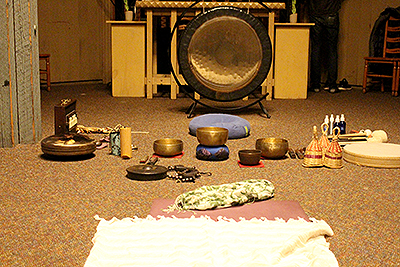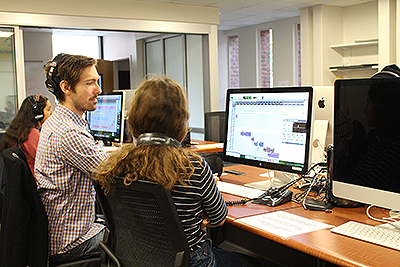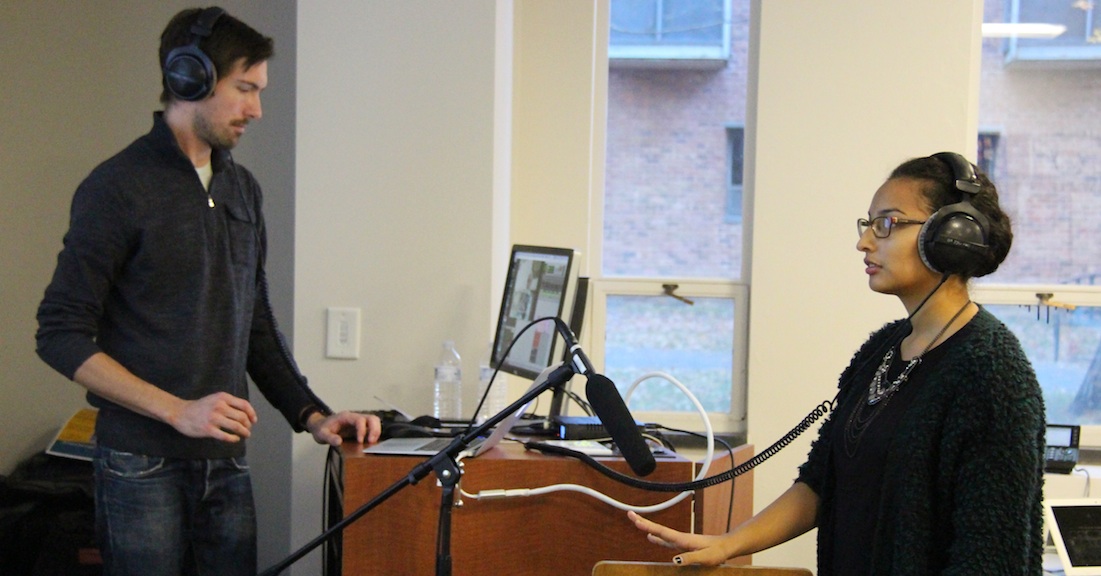Doc on Campus: Jesse Flower-Ambroch: Exploring the power of creativity and sound
MDOCS hosted Skidmore alum Jesse Flower-Ambroch '06 October 22–24 for a mini residency on sound design for film. Flower-Ambroch led a sound meditation, offered critiques and advice to students in Adam Tinkle's Intro to audio doc class, visited Eliza Kent's Hindu myth class (religious studies) and led a workshop on Foley sound effects for film. Rebecca Stern '16 introduces Flower-Ambroch's adventures in sound and Foley workshop participant Emily Rizzo '18 reports on the workshop as an ear-opening experience.
Adventures in sound…with Jesse Flower-Ambroch, '06
by Rebecca Stern

Sound Meditation set up, Wilson Chapel
When Jesse Flower-Ambroch discusses his work, he stresses how important collaboration is. As a sound designer and sound mixer who has his own production studio in New York City, he contributes just one piece to the many layers that make up a motion picture. Jesse knew he always had a connection to sound, and in 2002 came to Skidmore College as a freshman with a guitar. He flirted with various academic departments but circled back to declaring a music major. Jesse felt unrestricted by his major and integrated his sound knowledge with other mediums at Skidmore such as theater and art. In the spirit of collaboration, after graduating in 2006, he worked for various music and theater clubs and wound up working on a film set after meeting a “sound guy.” His only previous experience with film was with his thesis, where he stripped and redid the sound palette for an archival video.
Since then, Jesse has worked on various projects such as Jodorowsky’s Dune, Shut Up and Play the Hits and Knicks Poetry Slam, for which he received an Emmy nomination. Jesse’s work has taken him from the ocean on a boat for weeks on end to AA meetings, to the Congo, where he meets “people you’d never get a chance to meet, random people, with different perspectives on life and different stories.” For Jesse, sound is a transient medium that can tell and enhance any story or experience.
In his sound travels, Jesse has found himself attracted to the mental and physical benefits of sound meditation. A trained practitioner, Jesse leads sound meditations for anyone from small groups of friends in his New York City apartment to large corporate teams and public gatherings. We were lucky enough to have him guide us on a session in Wilson Chapel.

Jesse working one-on-one with students in
Adam Tinkle's Inro to Audio class.
The creation of Foley
by Emily Rizzo, '18
Jesse Flower-Ambroch’s workshop, “Art of Sound Effect for Film,” taught me about the hidden intricacies and challenges of creating the sound effects that provide depth and realness to moving images. In the beginning of the workshop, Jesse showed a clip from a film. It was then our job as participants to add the subtle sound effects that were missing. I had trouble imagining what kind of sounds we could add to this seemingly stagnant moment. The scene was of a man sitting on a living room chair, having a conversation with a woman sitting across from him. But then Jesse pointed out the man’s hand. His fingers were moving up and down, softly grazing the top of the armrest of the chair. In reality, this would create a diluted tapping sound.
Jesse proceeded to roam around the room and tap on all the different hard surfaces. This live reproduction of everyday sounds to create sound effects is called “Foley.” We had to find something that would match the sound of an old wooden chair. I listened closely to each tap, shaking my head after each one. None of the surfaces were quite right. For example, a tap on the table in front of me sounded much harsher and shallower than taps on a wooden chair would be. The more and more we failed, the more I realized how creative and spontaneous this job of producing sound effects for film really is. It requires you to separate the visual from the audio, to allow yourself to view an object as one thing but imagine its potential to represent something completely different through sound. When we didn’t find anything that fit the sound of the armchair, Jesse dashed out of the room. Moments later he wheeled in a portable bookshelf, knocked on it, and I knew he had found what our ears had been searching for.

Jesse Flower-Ambroch guides Julianna Quiroz
in adding sound effects to a scene.
The difference between not having any sound effects and hearing the sound of the man’s fingers on the rich wood was drastic. When we recorded and added this soft tapping noise to the scene, the scene felt more real. This realness provided by the sound effects is what I believe all of us, as audience members, underestimate. I felt less like an observer and more like I was actually there. The sound effects are essential in order to feel transported to a different time or place.
